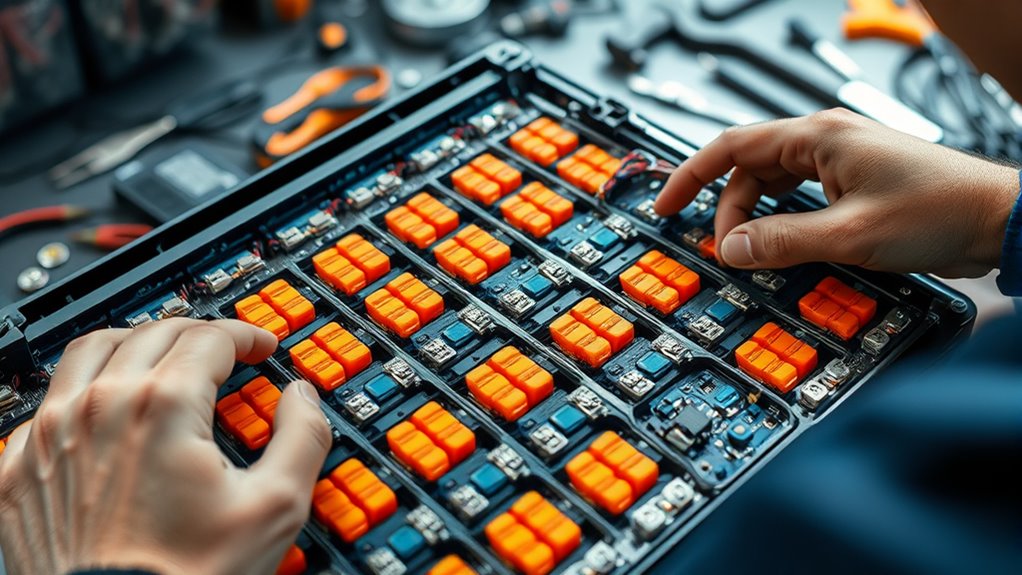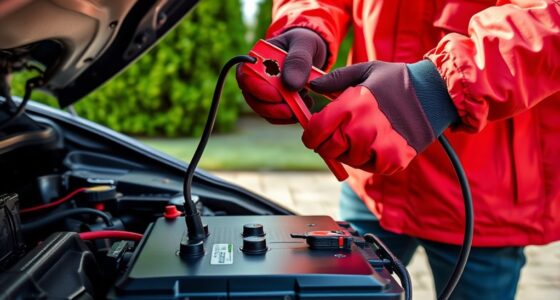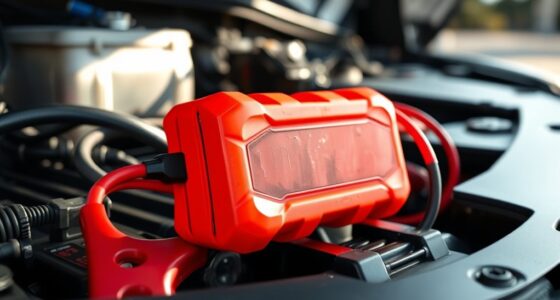To recondition your EV battery, focus on balancing the modules to restore uniform charge levels and extend lifespan. Proper module replacement is vital for addressing damaged cells, which can improve capacity and safety. Understanding your battery chemistry helps choose the right techniques, preventing damage during maintenance. Accurate calibration of your charger ensures safe, effective cycles. By following these steps, you’ll optimize performance and longevity. Keep exploring to learn more about maintaining your battery’s health effectively.
Key Takeaways
- Proper module balancing restores capacity and prevents voltage discrepancies, extending battery lifespan.
- Understanding battery chemistry guides effective balancing and module replacement strategies.
- Accurate charger calibration ensures safe and effective reconditioning cycles.
- Controlled charging/discharging cycles help break down crystal buildup and improve battery health.
- Regular maintenance based on chemistry knowledge prevents damage and optimizes reconditioning outcomes.

If you’re looking to extend the life of your electric vehicle’s battery, reconditioning offers a practical solution. One key aspect of this process involves understanding battery chemistry, which influences how your battery responds to reconditioning efforts. Different EV batteries use varying chemistries, such as lithium-ion, nickel-manganese-cobalt (NMC), or lithium-polymer, each with unique characteristics and vulnerabilities. Knowing the specific chemistry helps you identify the best reconditioning techniques and avoid damaging the cells further. It also guides you in effectively balancing the modules, ensuring each cell receives an appropriate charge to prevent over- or under-voltage issues. Proper balancing restores battery capacity and maximizes performance, ultimately extending the battery’s lifespan.
Another essential step in reconditioning is charger calibration. Over time, chargers can drift from their ideal settings, leading to inaccurate readings and improper charging cycles. When reconditioning, it’s necessary to calibrate your charger to ensure it delivers the correct voltage and current. This calibration process involves testing and adjusting your charger against a known standard, so you know it’s providing accurate outputs. Correct calibration prevents overcharging, which can cause thermal runaway or damage to the cells, and undercharging, which hampers capacity recovery. With a properly calibrated charger, you can safely cycle the battery through controlled charge and discharge processes, helping to break down crystal formations and reverse voltage imbalances caused by aging or uneven cell degradation. Additionally, understanding battery chemistry can help you select the most effective balancing and replacement strategies for your specific battery type.
Frequently Asked Questions
How Often Should EV Batteries Be Reconditioned for Optimal Performance?
You should recondition your EV battery every 6 to 12 months, depending on your driving habits and charging cycles. Regular battery maintenance helps prevent capacity loss and prolongs performance. Keep an eye on your battery’s health, especially if you notice reduced range or slower charging. Reconditioning guarantees the cells are balanced and functioning at their best, so your EV continues to perform reliably and efficiently over time.
What Are the Signs Indicating a Battery Needs Balancing or Module Replacement?
Think of your EV battery as a symphony; when one instrument falls out of tune, the entire performance suffers. If you notice erratic charging behavior, sudden drops in range, or uneven battery health readings, it’s a sign to balance or replace modules. These issues indicate your battery isn’t harmonizing properly, and addressing them guarantees your EV runs smoothly, keeps its charge, and delivers peak performance every time you hit the road.
Can EV Battery Reconditioning Extend the Overall Lifespan of the Vehicle?
Yes, EV battery reconditioning can extend your vehicle’s lifespan by improving battery health. By addressing issues related to battery chemistry and optimizing charging cycles, reconditioning helps restore capacity and efficiency. Regular maintenance reduces wear and tear, allowing you to get more miles from each charge. This process can delay the need for costly replacements, keeping your EV running smoothly and reliably for years to come.
Are There Any Safety Risks Involved in Battery Balancing and Module Replacement?
Yes, there are safety risks involved in battery balancing and module replacement. You should be cautious of chemical hazards from battery acids and chemicals, which can cause burns or poisoning if mishandled. Additionally, electrical shock is a real danger if you don’t disconnect power properly. Always wear protective gear, follow safety protocols, and handle components carefully to minimize these risks and guarantee your safety during the process.
How Does Reconditioning Impact the Warranty of an EV Battery?
Think of reconditioning as a delicate dance with your EV’s warranty. If done correctly, it can extend your battery’s life and may not void your warranty, but beware—some manufacturer policies see reconditioning as tampering, risking warranty implications. Always check your manufacturer’s policies before reconditioning. You hold the keys; understanding these policies helps you navigate the fine line between preservation and warranty risks.
Conclusion
Now that you know the essentials of balancing and module replacement, you’re closer to extending your EV battery’s life. But there’s more to discover—advanced techniques that could unleash even greater performance and longevity. Will you take the next step and explore deeper into reconditioning methods? Stay tuned, because the secrets to maximizing your EV battery’s potential might just change the way you drive forever. Are you ready to release its full power? The journey isn’t over yet.









